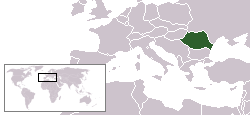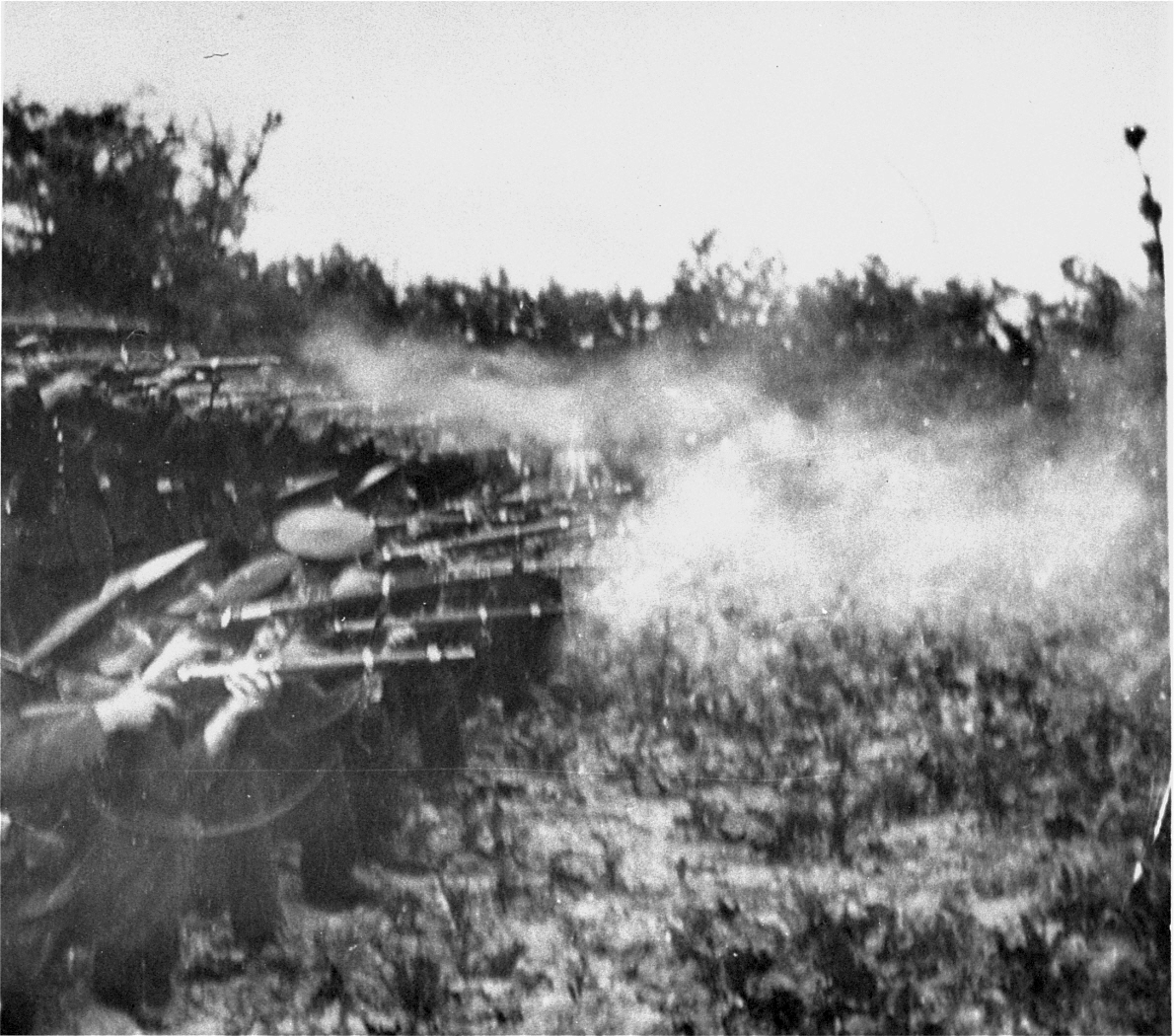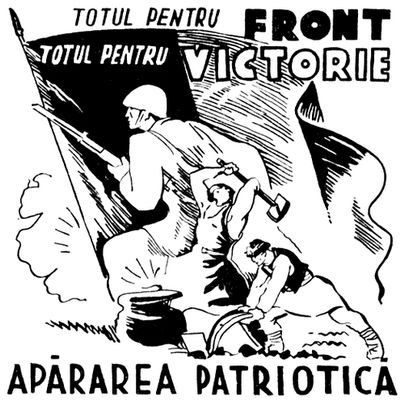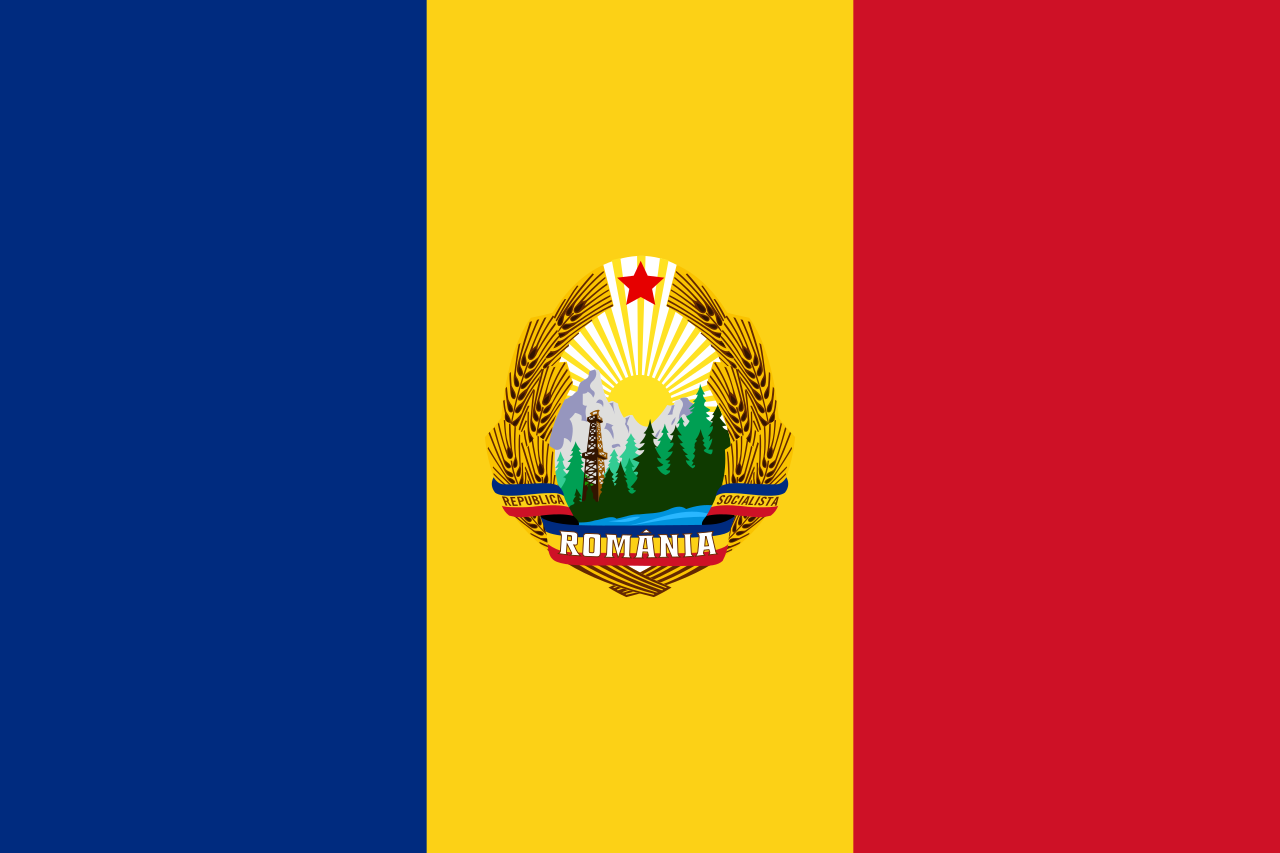More languages
More actions
| Romanian People's Republic (1947–1965) Republica Populară Romînă Socialist Republic of Romania (1965–1989) Republica Socialistă România | |
|---|---|
| 1947–1989 | |
Motto: Proletari din toate țările, uniți-vă! ("Proletarians of all countries, unite!") | |
Anthem: Zdrobite Cătușe (1948–1953) Te slăvim, Românie (1953–1977) Trei Culori (1977–1989) | |
 | |
| Capital | Bucharest |
| Official languages | Romanian |
| Dominant mode of production | Socialism |
| Government | Unitary Marxist-Leninist socialist republic |
| General Secretary | |
• 1944-1954 | Gheorghe Gheorghiu-Dej |
• 1954-1955 | Gheorghe Apostol |
• 1955-1965 | Gheorghe Gheorghiu-Dej |
• 1965-1989 | Nicolae Ceaușescu |
| Head of State | |
• 1947-1952 (first) | Constantin Ion Parhon |
• 1967-1989 (last) | Nicolae Ceaușescu |
| President of the Council of Ministers | |
• 1947-1952 (first) | Petru Groza |
• 1982-1989 (last) | Constantin Dăscălescu |
| Legislature | Grand National Assembly (Marea Adunare Națională) |
| History | |
• Proclamation of the Republic | 30 December 1947 |
• First Constitution | 13 April 1948 |
• Second Constitution | 24 September 1952 |
• Third Constitution | 21 August 1965 |
• De facto disestablished | 27 December 1989 |
• De jure disestablished | 8 December 1991 |
| Area | |
• Total | 238,397 km² |
| Population | |
• 1989 estimate | 23,151,564 |
• Density | 97.11 per km² |
| Labour | |
• Labour force | 10.69 million (1987)[1] |
• Occupation | 34% industry, 28% agriculture, 38% other[1] |
| GDP (nominal) | 1988 estimate |
• Total | $151.3 billion (1989 US Dollars)[2] |
• Per capita | $6,570 (1989 US Dollars)[2] |
| Exports | 1988 estimate |
• Value | $11.5 billion[1] |
• Commodities | Machinery and equipment (34.7%), fuels, minerals and metals (24.7%), manufactured consumer goods (16.9%), agricultural materials and forestry products (11.9%), other (11.6%) (1986)[1] |
• Partners | USSR (27%), Eastern Europe (23%), EC (15%), US (5%), China (4%) (1987)[1] |
| Imports | 1988 estimate |
• Value | $8.75 billion[1] |
• Commodities | Fuels, minerals, and metals (51.0%), machinery and equipment (26.7%), agricultural and forestry products (11.0%), manufactured consumer goods (4.2%) (1986)[1] |
• Partners | Socialist states (60%), non-socialist states (40%) (1987)[1] |
| External debt | None (1989)[1] |
| HDI (1990 report) | 0.863[3] |
| Currency | Romanian Leu |
| Calling code | +40 |
| Today part of | Romania |
The Socialist Republic of Romania (Romanian: Republica Socialistă România, RSR) was a socialist state that existed from December 1947 to December 1989. The Marxist-Leninist government ruled until 1989, when the Romanian leader Nicolae Ceaușescu was overthrown and the government replaced with one aligned with Western capitalist interests.
Names
- Romanian People's Republic (Republica Populară Română, RPR) (1947–1953; 1964–1965)
- Romanian People's Republic (Republica Populară Romînă, RPR) (1953–1964)
- Socialist Republic of Romania (Republica Socialistă România, RSR) (1965–1989)
History
August 1944 coup d'état
On the night of the 13–14 June 1944, representatives of the Romanian Communist Party (PCR) presented their plan for the removal of fascist leader Ion Antonescu from power to the representatives of the King.
The proposed plan would have King Michael order Antonescu to sign an armistice with the Allies and, if he refused, have him arrested on the spot.
The coup was carried out on 23 August 1944, following the plan proposed by the PCR. After an hour-long discussion with the King, Antonescu refused to sign the armistice, and was arrested by a colonel and four soldiers. Antonescu was executed two years later, on 1 June 1946.
On the day of Antonescu's arrest, the Romanian army switched sides and began fighting against the Nazis along with the Soviet Union.[4] Following this, a government formed by the National Democratic Front (FND; consisting of the Communist Party, as well as the National Liberal Party (PNL), the National Peasants' Party (PNȚ) and the Social Democratic Party (PSD)) would take power.[5]


Socialist rule
Gheorghe Gheorghiu-Dej
In 1946, Romania held its largest election ever, with 4.77 million people voting for the Communist-led Bloc of Democratic Parties (BPD), formerly the National Democratic Front.[6] The new government forced King Michael to abdicate. In 1948, the PCR and PSD merged to form the Romanian Workers' Party (PMR), led by Gheorghe Gheorghiu-Dej. The country began an electrification plan and confiscated farmland, mansions, and castles from the nobility. Under socialism, industrial output increased by more than seven times and the life expectancy rose by 30 years. By 1980, the socialist government had built 4.6 million houses.
Romania joined the Warsaw Pact in 1955. With Chinese support, it negotiated the removal of Soviet soldiers from Romania and was neutral during the Sino-Soviet Split.
Nicolae Ceaușescu
Gheorghiu-Dej died in 1965 and Nicolae Ceaușescu succeeded him as General Secretary. Ceaușescu ran the country on a platform of Romanian nationalism, wanting to make Romania a world power, and sought out Western financial aid from institutions such as the IMF and World Bank. In the 1980s, Romania had to ration electricity and food due to IMF austerity measures.[4]
Counter-revolution
In April 1989, Romania finished paying its debt to the IMF and banned taking any further loans from the West. On 21 December 1989, Ceaușescu announced he would raise wages and pensions.[4]
In December 1989, protestors attacked police and began a brief civil war that overthrew the socialist government of Romania. Hundreds of police and soldiers were killed as well as 142 protestors. The CIA-backed Western media claimed that Romania killed over 60,000 peaceful protestors.[7]
Economy
Industry
The average annual increase in gross output during the years 1951–1974 was 13%. The group of industries producing means of production is developing at a faster pace. During the years of people's power in the field of heavy industry, such industries as machine tool building, tractor and automobile construction, large-tonnage shipbuilding, production of electric diesel locomotives, oil, energy, mining, chemical and other production and technological equipment, electronics industry, as well as petrochemicals, etc. were created.[8]
The construction materials industry developed across the board. The production of consumer goods also increased significantly, satisfying the ever-increasing demand of the population. Industrial development increased year after year. Modern technology was introduced into all sectors of the economy. An important trend in industrial development was the increasing degree of development and use of the country's natural resources. As a result, serious structural changes occurred in industry:[8]
| Industry | Gross production (%) | Workforce (%) |
|---|---|---|
| Electricity generation | 2.7 | 1.5 |
| Fuel production | 3.9 | 3.8 |
| Oil production | 2.3 | 1.4 |
| Ferrous metallurgy | 7.7 | 3.3 |
| Non-ferrous metallurgy | 2.7 | 2.7 |
| Mechanical engineering | 30.5 | 31.0 |
| Chemicals | 11.2 | 6.7 |
| Construction materials | 3.1 | 4.5 |
| Forestry and woodworking | 5.0 | 11.7 |
| Pulp and paper | 1.2 | 1.3 |
| Textiles | 7.3 | 12.0 |
| Sewing | 5.2 | 6.4 |
| Leather and footwear | 1.9 | 4.0 |
| Foodstuffs | 14.2 | 8.0 |
| Other | 1.1 | 1.7 |
| Source: Great Soviet Encyclopedia - Romania[8] | ||
| Industrial Product | 1938 | 1950 | 1960 | 1974 |
|---|---|---|---|---|
| Electricity (billions of kWh) | 1.1 | 2.1 | 7.7 | 49.1 |
| Coal (millions of tons) | 2.8 | 3.9 | 8.2 | 29.2 |
| Lignite (millions of tons) | 0.3 | 0.8 | 3.1 | 20.0 |
| Oil (millions of tons) | 6.6 | 5.0 | 11.5 | 14.5 |
| Natural Gas (billions of m3) | 2.0 | 3.4 | 10.3 | 30.1 |
| Steel (millions of tons) | 0.3 | 0.6 | 1.8 | 8.8 |
| Aluminium (thousands of tons) | – | – | – | 187 |
| Sulfuric Acid (thousands of tons) | 44 | 52 | 226 | 1358 |
| Fertilizers (thousands of tons) | – | 0.6 | 71 | 1410 |
| Plastics and resins (thousands of tons) | – | 0.4 | 12.4 | 283 |
| Chemical fibers (thousands of tons) | 0.9 | 2.3 | 4.1 | 159
(including yarn) |
| Synthetic fibers (thousands of tons) | – | – | 0.9 | 96 |
| Trucks (thousands of units) | – | – | 8.4 | 31.5 |
| Passenger cars (thousands of units) | – | – | 1.2 | 67.5 |
| Tractors (thousands of units) | – | 3.5 | 17.1 | 44.6 |
| Metalworking machines (thousands of units) | – | – | 4.4 | 24.8 |
| Lumber (millions of m3) | 2.2 | 3.6 | 3.9 | 4.8 |
| Cement (millions of tons) | 0.5 | 1.0 | 3.1 | 11.2 |
| Cotton fabrics (millions of m2) | 104 | 148 | 248 | 612 |
| Sugar (thousands of tons) | 95 | 87 | 391 | 516 |
| Vegetable oils (thousands of tons) | 18 | 36 | 118 | 332 |
| Canned fruits and vegetables (thousands of tons) | 2.4 | 33 | 75 | 504 |
| Source: Great Soviet Encyclopedia - Romania[8] | ||||
References
- ↑ 1.0 1.1 1.2 1.3 1.4 1.5 1.6 1.7 1.8 CIA World Factbook (1990). Romania – World Factbook (Wikisource)
- ↑ 2.0 2.1 CIA World Factbook (1989). Romania – World Factbook (theodora.com)
- ↑ Human Development Report 1990, p. 111
- ↑ 4.0 4.1 4.2 Patricia Gorky (2019-12-26). "Romania: 30 years removed from socialism" Liberation News. Archived from the original on 2022-03-19. Retrieved 2022-10-08.
- ↑ Silviu Brucan (1993). The Wasted Generation: Memoirs of the Romanian Journey from Capitalism to Socialism and Back (pp. 20-21). Westview Press.
- ↑ Nohlen, D & Stöver, P (2010). Elections in Europe: A data handbook (pp. 1603-1610). ISBN 978-3-8329-5609-7
- ↑ Austin Murphy (2000). The Triumph of Evil: 'The Documented Facts about Eastern Europe and Communism: A Refutation of Popular Myths about the True Good Guys' (p. 74). [PDF] Fucecchio, Italy: European Press Academic Publishing. ISBN 8883980026
- ↑ 8.0 8.1 8.2 8.3 Great Soviet Encyclopedia: 'Romania'.


